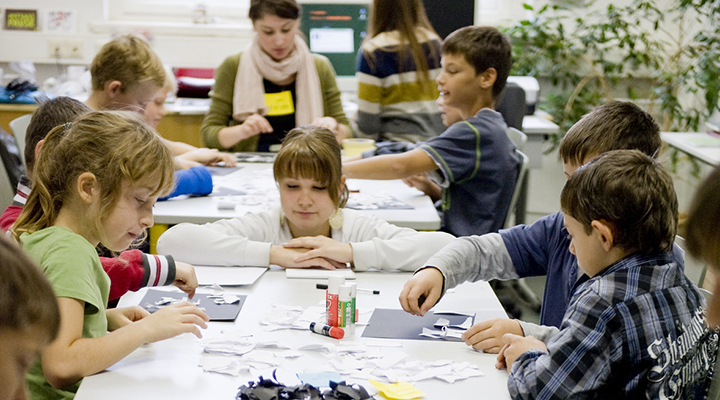There are two divisions at the department of art education which work together very closely: The division of Theory and Didactics in Fine Art and the Practical Division of Fine Art, Design and New Media.

Division of Theory and Didactics in Fine Art
In the courses which familiarize students with the nature of artistic works and processes, insights in the structure and development of artistic production, reception, and reflection are gained. Students also learn about the language of form and colour, as well as about the particular nature and development of artistic creativity. In dealing with these topics, examples of modern art are viewed and students gain insights into the important developmental tendencies and conceptual problems of art as well.
The courses in didactics, which relate to the topics mentioned above, familiarize students with the nature, structure, and development of pedagogically guided processes and the particular nature of their results. Through various types of practical training in schools as well as through participation in non school-related projects, students turn theory into practice and gain knowledge through individual experience. In the multimedia courses students experiment with play and action forms which challenge and exceed the borders of fine art. Scientific research at the institute is conducted varyingly by students, alumni, as well as those working on their doctorates. Areas of concentration include the research of creativity and the foundations of understanding and teaching modern art.
Chair of Art Education / Didactics in Art:
Prof. Dr. Ines Seumel, Head of the Department
Art Education (scholastic, non-scholastic) – Multimedia Action:
Prof. Dr. Ines Seumel
Art Education (scholastic, non-scholastic)
Mandy Putz
Sarah Heuer
Practical Division of Fine Art, Design and New Media
Fine Art
Apart from the theoretical courses, the practical aspects of studies also play and important role. Practical training occurs in studios and in small groups. The institute is equipped with several printing workshops, a hand setting room, and a papermaking workshop. Supporting students during artistic training in the areas of painting, graphic arts, classical procedures, sculpture/object art, multimedia, graphic design and product design are known artists who exemplify their artistic positions and who demonstrate ways of developing one’s own artistic individuality.
The artistic, practical courses gearing students toward creative competency and skill are mandatory requirements for teaching art in schools where the development of creativity is encouraged. Studies are conceptually connected with contemporary art and provide many opportunities for artistic expression. Different types of techniques, from drawing, painting, and printing techniques to techniques for object art, calligraphy, installation art, performance art, multimedia design (ex. video), as well as for commercial art crafts and design are learned and can become the foundations for individual exploration. During the course of studies, working independently and intensely in selected areas becomes increasingly important.
Design and New Media
Practical courses in graphic design are also included in studies gearing students toward creative competency and ability. Courses include areas belonging to the many branches of graphic design, for example calligraphy, typography, and commercial marketing. The necessary historical and theoretical foundations are continuously taught in connection with the practical aspects. In the area of script design, script and writing are viewed from an art pedagogical standpoint as essential components of our society.
Apart from writing exercises and exercises in calligraphy, ways of incorporating the practical aspects of script design in schools are also investigated. In the area of product design, works from the 19th and 20th century are viewed as a means of exploring this area. Students simultaneously gain insights into important developmental phases and conceptual problems. Through theoretical reflection, productive creation, and receptive application, students learn the specifics of product design as well as the complex system of product design from craft production to industrial design. Multimedia studios equipped with high level technology offer the utmost best conditions for creative work in the varying areas of new media, especially in the applied areas of art education.
Chair of Design and New Media in Art Education
Graphic Design – Typography – New Media:
Prof. Andreas Wendt
Product Design – New Media:
Alexander Frohberg, Head of the Aptitude Test
New Media – Typography:
Dr. Monika Masłoń
Painting – Graphic Arts:
Verena Landau
Maria Sainz Rueda (Exhibition manager)
Sculpture – Object Arts – Installation Art:
Tobias Rost
Graphic Arts – Printmaking:
Markus Laube, Head of Printing Workshops